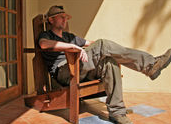
"DAY 1: MANCHESTER, LONDON, AMMAN
I left home at a sensible hour this morning - 08h30 - and headed up the M6 to Manchester Airport in the glorious spring sunshine. It's only a short trip to T3 from the car park and from there, a short trip down to London on one of the smaller planes in the BMI fleet. I guess there were no more than 20 of us on the flight although in such a small plane, that seemed a lot! It was full!
Plenty of time to check-in for the flight to Jordan and someone must have liked me, because I was pulled out of the queue and whisked to the Crown Class desk and checked in ahead of this group. I notice that I'm in Row 9 - I wonder whether I'll get the china crockery!
Some four hours later, we crossed the Israeli coast just north of Tel Aviv and eventually landed in Amman at 23h30. Or was it 00h30? The pilot bade us Good morning but the clocks said 23h30. I'm aware that Summer Time in Jordan starts on the last Thursday in March, so I was convinced it was actually 00h30. However, the clocks in the terminal building didn't agree.
Leaving the plane, I was immediately met by our rep; he would arrange our (free) visa. Two other couples joined us and we five passed through the Crew and Staff only gate and had our passports taken away for stamping. The others retrieved their suitcases (yes - suitcases) very quickly, whilst my rucksack was almost the last bag off the plane.

We went into the cold Amman early morning and boarded our coach to the hotel.
DAY 2: OF CASTLES AND KINGS
Despite being very tired, I found it difficult to sleep in a very cold room (the windows had been left open) with a pillow the size of a small mountain. Nevertheless, I must have slept because the alarm woke me at 07h30 and the pillow was on the floor.

Breakfast was a simple affair with bread, jam, oranges, dates and some funny green stuff. The introductory chat was interesting and before long, it was all over and we had to go and get ourselves ready for the day.
Back downstairs by 09h00, I found myself part of a group of nine comprising three couples (yes - one was genuinely called Sam 'n' Ella) and 3 singles. We were introduced to our guide for the week - Bassam, a Jordanian living in Hungary.
Bassam had an alternative to our itinerary: Today, we would do an extra castle rather than spend some time in Amman and tomorrow we would do one of the castles earmarked for later in the week. This would give one completely free day which would be filled with a visit to Jesus' Baptism site and a hike to some hot water springs. Without question, we all agreed.
Ajlun - Saladin's Fortress
It had been raining during breakfast but now, the sun was shining and we all clambered aboard our bus. As we headed north towards Ajlun, Bassam began to tell us the history of Jordan and the history of the Royal Family.

In the cool morning air, the rocky scrub land gave way to greener hills the farther north we ventured. Up and down hill we went, ever northwards through the biblical hills of Gilead with its olive groves until we arrived in the village of Ajlun. Being a Sunday, the first day of the working week, the village was busy with traders buying and selling beneath the view of the 600 year old minaret.

We headed through the town and up towards the peak of a hill overlooking the village. There, sitting, literally, squarely on the summit, was a ruined castle.
It turns out that this castle is a fine example of Islamic military architecture. It was build in the late 12th century by Saladin and comprised seven towers and a moat some 40' deep. Not bad as it sits astride a hill top. Due to its position overlooking the Jordan valley, the castle was an important link in the chain of castles built to defend against the Crusaders.

We got out of the coach and were put on board a little local bus and taken to the castle doors. There, we were greeted by an elderly gentleman selling fresh coffee. After a refreshingly hot drink in the surprisingly chilly air, we made out way up the ramp and into the castle.
Although I've seen castles all over the UK, this was a new departure. Saladin had been very cunning in designing his arrow slits. Although there was a slot in the wall, it was at waist height inside a large niche. This meant that two or three archers could man each slot rather than just one.

We continued up the main entrance and passed underneath the portcullis. There, our guide led us through a private door and we went to see a part of the castle not open to the public. Stone balls were evident as were beautiful carvings and, as we wound our way around the castle, we got higher and higher until we found ourselves in the sunshine, in the wind and on the roof. Boy was it cold. I'm in the Middle East for heaven's sake - it should not be cold! Mind you, the view across to the Jordan River and Israel was absolutely stunning - the castle was certainly built in an amazing place.
Jerash - A Hidden Gem
At Jerash, Time Team would have a field day and I reckon would not bother looking at anything Roman because we know it's there and probably come away having found the only Neolithic site in the area!
Jerash originally had a population of about 200,000 people and existed solely due to the good agricultural land in the area. Walking around the site, it's very easy to imagine a bustling city, with shops, fountains, people milling and entertainment.
Although there had been a Roman presence for some time, it wasn't until the 1st century AD that the city that's seen today was laid out.
In AD129, Hadrian (him of the Wall) visited and in celebration, a triumphal arch was built. As we entered the site, a Roman soldier stood atop the arch and blew his trumpet announcing the start of the games. We didn't go and see the games, preferring to see the sites instead.
We entered the absolutely spectacular Oval Plaza. This plaza is absolutely huge with a central fountain. 56 Ionic columns surround the plaza yet don't confine it. Making our way to the Temple of Zeus, we were drawn to the sound of bagpipes coming the South Theatre.

There, we found the Massed Bands of the Jordanian Bagpipers entertaining a few spectators, far fewer than the 5000 seating capacity. Standing in the middle of the amphitheatre, it is interesting to whisper to the audience and hear your whisper immediately in yours ears - a testament to the superb acoustics even now, some 2000 years after the theatre was built.
Returning to Amman, we walked into the city to explore the City Mall, grab a bite to eat and settle into the bar for a drink and contemplate another early start.
DAY 3: MORE CASTLES AND KINGS
07h00 came surprisingly early but after taking a shower and dressing, I packed my rucksack and headed down to breakfast.Returning to my room, I packed my washing kit and headed down to reception to checkout.
At 08h15, we climbed into the bus and headed off for the first stop of the day.
Mosaics and Moses
About an hour after leaving Amman, we arrived on a large building site known as Madaba. Making our way along unmade roads, our bus pulled into the car park and we descended into the sun.
Madaba is the most important Christian centre in Jordan and is a shining example of how Christian and Muslim can live together. Historically, this Moabite town was one of those divided amongst the twelve tribes of Israel. It changed hands several times through history until the middle of the 8th century when the town was devastated by an earthquake and abandoned.

In the late 19th century, the town was again becoming settled, at which point, the now famous mosaics were found. One such mosaic is a map of the Holy Land which, when news reached Europe of its discovery in 1897, brought about a keen archaeological presence, continuing today.

Walking through the town, we headed for the Greek Orthodox Church of St. George to view this famous map. Unearthed in 1884, it was actually put together in 560 and depicts 157 Biblical sites in the Middle East, some unknown at the time of rediscovery. The mosaic is some 40' long and 18' wide and built from over two million pieces. Oh, and spectacular!

Returning to the bus, we drove a short distance, up hill, until we came to a spectacular view. This was Mount Nebo. Both the Old Testament and the Koran tell of Moses being commanded to go to Mount Nebo in Moab and to view the land of Canaan, which will be given to the Israelites. However, Moses will not enter the Promised Land but die on Mount Nebo. There's a little museum on the top which, although contains some pottery, is mainly displaying maps from the different ages affecting Mount Nebo.

Climbing the mountain, the view down into the Jordan Valley across to the Dead Sea is breathtaking. With desert all around, a little strip of blue is just visible as is the great rip in the Earth's crust which is the Jordan Valley.
Taking the King's Highway to Karak
Settling back down in our seats, we had a few hours to kill on our journey south. There are several roads heading in our direction, but we had decided to follow a road that has been in continuous use for over 3000 years.

Known as the King's Highway or the Road of the Sultan, the road has been followed by the Israelites en route to the promised land, the traders making their way to and from Petra, pilgrims heading for Moses' memorial on Mount Nebo, Crusaders heading to their castles and Muslims on their pilgrimage to Mecca.
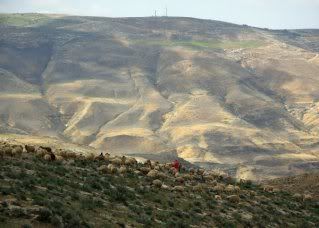
The journey south along the road took us through some unbelievably beautiful desert scenery. Stunning views and twisting roads took us down to the river before ascending back up the other side and on to the top. Barren rocks and sand occasionally interspersed with green oasis where the water flowed close enough to the surface to support plant life.
At 13h30, we eventually pulled into Karak, roughly a third of the way between Amman and Petra. Just before be descended into the city, our driver stopped so that we could take photos of the imposing Crusader castle. Occupying the entire ridge, the city has encroached into the castle but nevertheless, it still dominates the skyline.

First things first - we had lunch, taking salads and meat balls before heading off into the castle. This was very different to that of Ajlun, which was built in the Islamic style. Karak, however, was manned, not only by soldiers, but by their families too. Consequently, it is much bigger than Ajlun.
Karak is an ancient city laying on the caravan route between Egypt and Syria. It is also mentioned several times in the Bible.
Standing on the walls, it is easy to see why this location was chosen as the views over the surrounding countryside meant that no one could approach in secret.

That evening saw us in a deserted village hanging onto the side of the Jordan Valley. There, we had simple accommodation, simple food but good company.
DAY 4: DANA AND PETRA
I awoke before the alarm this morning. Not because I wasn't tired but because I thought I'd overslept! 45 minutes before breakfast and I was wandering around in the early morning sun taking photographs across the valley into Israel.

We packed our bags into the bus but set off on a three hour walk into the Dana Nature Reserve. We walked through the deserted village and headed off through some long neglected gardens and onto the mountain side. Although we saw evidence of porcupines and irises, the only wildlife to speak of came in the form of an eagle soaring overhead.

Somewhat disappointed by the lack of fauna, we arrived back at the bus and settled down for the ride to Petra.
In which nothing prepares you for the sight
As we were driving south, there was some discussion as to the events of the afternoon: several of us wished to take a 2-day pass into Petra and try and see something away from the main tourist route. After much group discussion, it was agreed that we'd all go to Petra this afternoon and climb to the highest point.
Having checked into the hotel, which couldn't be closer to Petra, we dined on barbecued chicken, humus and salad, etc. Then, grabbing the camera and leaving the others to their own devices, I set off down the track leading to the Siq - a half mile narrow gorge leading into the hidden valley.

Running down the side of the Siq is a channel carved into the rock which originally brought water into the city. There were surprises around every corner even when walking down the Siq whether it be the way the sun illuminated a particular rock or a little carving. However, nothing can prepare you for the view at the end - rounding the last corner and there, in front of you, framed by the dark walls of the Siq, the rose-red Treasury building. Undoubtedly one of the most awe-inspiring views in the world.
Today's visit though, is not about the main buildings of Petra, so, without paying too much attention, I headed down the main street until I came to a flight of steps heading almost vertically up the side of the mountain. It was slow going in the heat, but I pressed on up the step, along narrow cracks in the rock, all the while getting higher and higher.
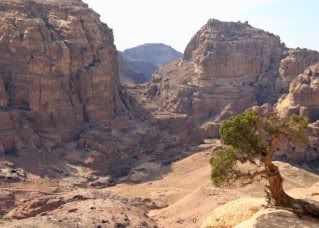
Near the summit, I passed two obelisks before finally, after a little climb reached the High Place of Sacrifice. Whilst the archaeology on the summit may not be all that visually exciting, the views down to the Royal Tombs are breathtaking. It's worth the climb just for that! Having had a drink of water, I met up with the two Ninas, who had set off before lunch. They were at the summit admiring the view.

Climbing back down to the obelisks, we decided on a circular route back to the Siq and so headed off down a steep set of steps hidden in the rocks. Continuing down the side of the cliff, we descended steep stairs and, suddenly, rounding a corner, were met by a most amazing site -the Garden Tomb, beautifully lit by the afternoon sun. To be honest, it looks more like a temple than a tomb.
From here on, everywhere you looked, there were hidden buildings and amazing rock colourations. You could not take a dozen steps before someone would shout out “Oh wow, look at that!”.

It was even more magical because there was no-one else around - all the crowds had gone back to their coaches, etc., and there were but a few hundred visitors in the entire city.
Continuing down the valley, we entered the Roman Soldier's Tomb and, although there were no obvious internal carvings, it was still an impressive building. The Garden Triclinium across though, was another site all together.

The inside of this building was beautifully carved with pretend pillars and made marvellous use of the incredible colours in the rock.
After a shower, I met the Ninas in the Cave Bar attached to the hotel - built inside a Nabataean tomb - where we revived our thirsts before heading off for a meal in the hotel.
DAY 5: PETRA - THE ROSE RED CITY
I cannot find the words to describe this awe inspiring city; in fact just look at the photos from my day instead!:







DAY 6: FROM THE CROWDS OF PETRA TO THE DESOLATE BEAUTY OF THE DESERT.
Packing and leaving the rucksack at the door, I headed down to breakfast and made a packed lunch from the bread and cheese available!
Ali came to collect us at 09h00 and we began the slow climb up from Petra to the summit of the surrounding hills and the plateau beyond. Upon reaching the summit, Ali stopped the bus to give us one last glimpse of Petra before we headed off along the King's Highway down to Wadi Rum.

The journey across the desert began on the outskirts of Petra with red sandstone rocks and slowly moved to yellow sandstone before finishing up with brown sand. We passed several camels along the route and numerous goat herds; all the while the heat was building up.
Just before midday, we finally pulled off the main road and began the final 8 miles into Wadi Rum. There, we unloaded our bags and went to our tents - our accommodation for the night is a Bedouin camp.


After a cup of sweet tea, we sat down to lunch.
Some of the group opted to take a camel ride and so, some 30 minutes later, a camel train of 5 left the camp with two of us following on foot - the official camp photographer! The little train moved out into the desert and into the heat.

Five camels making it seem easy to walk across the sand - two followers making it seem difficult. After an hour, we returned into camp, dismounted and drank a large quantity of water!
Come 15h00, we boarded our two jeeps and headed off into the desert for a four hour trip. Leaving the Bedouin Camp, we crossed the little railway line and started across the sand.
First stop was a little group of rock carvings depicting ibex drawn by the Hammoudians. Then we came to stop at a wonderfully tall sand dune. Whilst the energetic ones climbed to the top and ran down at high speed the rest of us partook of more sweet tea.

Again, more bumpy travel until we came to a magnificent rock bridge and a camel train. This particular bridge was not too easy to climb, and so we continued another quarter mile to a second bridge. The views across the desert were spectacular and the group decided to climb.
Finally, we stopped once more - to collect fire wood - before eventually stopping in the lee of an enormous rock where our drivers built a fire and we climbed to a platform in order to watch the sun go down.
Although there was some heat haze, the view across the desert to the distant hills, some 20 miles away, was spectacular.
Sadly, there were no clouds in the vicinity and so the sunset was not as spectacular as it could have been. However, to see the setting sun over such a remote part of the earth was awe inspiring,


Finally, after the sun dropped, we too dropped and joined our drivers in taking tea before returning to camp, a meal, some music and a night in a tent.
DAY 7: ACROSS THE DESERT AND FAR AWAY
The night under canvas went very quickly - for me. Others complained at the noise coming from the dogs, the little train, the odd vehicle, snoring, but I heard nothing - apart from the occasional mosquito trying to get a quick bite.
Breakfast was a simple affair - strong coffee, pitta bread dipped in olive oil and herbs and hard boiled eggs. By 07h00, the bus was packed and nine sleepy adventures headed for 5 hours across the Jordanian Desert back towards the north. To pass the time, we managed a group crossword, although next time I recommend that the person with the pen has some numeracy and language skills!
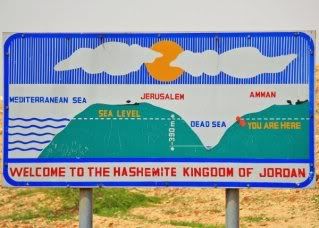
Coming off the Desert Highway, we joined the Dead Sea Highway. It seemed rather odd standing on the top of a cliff next to a sign indicating that you are at Sea Level!
The Dead Sea is also known as the Sea of Lot as, when Lot and his family fled the destruction that would befall the cities of Sodom and Gomorrah, Lot's wife turned to view the hand of God and was immediately turned into a pillar of salt.
After some 5 hours of travelling, we arrived at Bethany-Beyond-The-Jordan.
The fascinating history of this area included the place where John the Baptist preached, Jesus was baptised, the first five disciples met and thus, the foundations of early Christianity were laid. Jesus is believed to have come here en route from Galilee and spent three days here before heading into the nearby wilderness for 40 days. John was later arrested and beheaded by Herod nearby.
In keeping with the biblical struggles, the local area is not controlled by the Ministry of Tourism, but by the armed forces as the Jordan River, which is only a few feet wide at this point, is the border between Jordan and the Occupied West Bank.

Entering the site, we first stop at a modern baptism pool where filter water from the Jordan is used in the modern ceremonies. Walking through in the midday sun, we arrive at John the Baptists pool, where he is reputed to have himself been baptised.

Continuing through the wild flowers, we arrive at the baptism site; a pool next to the River Jordan where the remains of three churches have been found.

After filling some bottles with river water, we headed back to our bus and the luxury that would be our final day in Jordan. We were heading for a day of nothing by the Dead Sea.
DAY 8: PLAYING DEAD BY THE DEAD SEA
Today is the penultimate day of the trip. Today is a day of rest. Today, we are playing Dead!
After a very relaxing night's sleep, breakfast came round at 08h00 - in a restaurant. What luxury!

The only thing I have done today is swim in the Dead Sea - enjoy the photos, I'm not writing any more - I'm on holiday!!!!"
John went on our Petra & Wadi Rum trip. Visit our website for more information. The Adventure Company also offer many trips to Jordan.
You can also find a full account of John's stay in Jordan and other travels he has completed on his blog. Check out his amazing photos!
Thanks for reading!
The Adventure Company





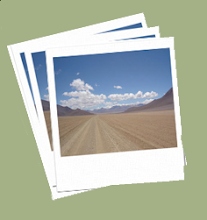
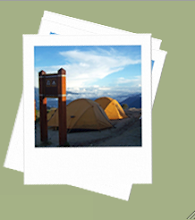






No comments:
Post a Comment